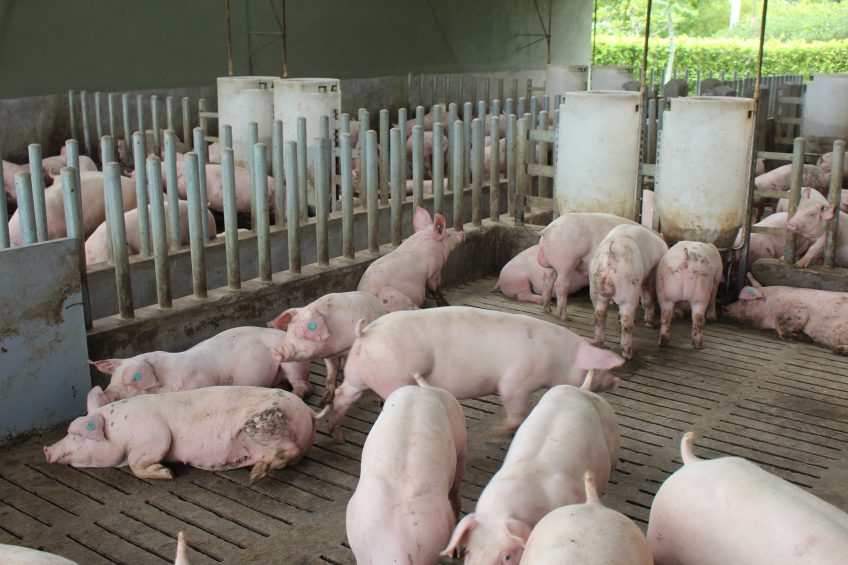A plea for ‘saleable Meat per Tonne of Feed’

‘Feed conversion ratio’ or ‘FCR’ appears to be the holy grail for the entire swine business – something pig management columnist John Gadd is not convinced of. Why not look at other parameters, he wonders? Think of MTF for a change.
I do get so frustrated by the casual use of FCR in the textbooks. In most cases, at its use at all! FCR is out of date and can be misleading. We have been used to seeing it as a useful benchmark for decades and it has become over-familiar. There is now a better measure of the performance of the growing/ finishing pig.
MTF is short for saleable Meat per Tonne of Feed. I make the case for it here. Casual use of FCR? Even the researchers and farm trialists don’t use it properly, failing to attach a suffix to each finding of ‘From when to when’.
‘Not comparing apples with apples’
Measuring FCR from 7 kg at weaning to 105 kg can give a 6% difference as from the usual weight on entering the nursery to a normal slaughter weight today. I find farmers comparing the worth of growing pig feeds/feeding systems using FCR on a disparate weight basis, i.e. ‘not comparing apples with apples’.
Anyway FCR as used today records live weight, not deadweight. We sell meat, not pigs. We are meat producers, not the old familiar term of pig producers!
MTF is far better for swine producers
MTF relates the producer’s total income against 58% to 68% of his total costs not just his food costs as with FCR. Yes, FCR is still an important measurement but MTF goes further. From many calculations from my clients records over 30 years of on-farm work MTF still preserves the FCR aspect to + or – 1% to 2% while FCR used alone as a measurement varied by as much as 6% to 8%, see Figure 1.
Figure 1 – Close relationship between FCR and MTF. Same farm, same pigs, FCR calculated on a three-month rolling average. MTF from the processor’s returns.

Moreover, to get a reasonably accurate FCR to assist in deciding which growing food to buy, involves a lot of measuring of both pigs and food. From my days in the feed trade responsible for investigating customers’ complaints about poor FCR showed that about half of them got it appreciably wrong anyway! Long ago maybe, but the on-farm errors are still there today I find, at a lesser degree but still economically misleading. FCR – (apart from the research trials under controlled conditions available to the researchers) are difficult and laborious to get right on a working farm.
No more pig weighing and measuring
No need to measure food consumed, this roll-over figure comes out of the farm office where feed invoices can be matched against pig turnover. No need to weigh batches of pigs either. The office again; it has paid returns based on carcass weight and grading for that same turnover of animals. The comparative work is done for you and enables the producer to measure the economic performance of his pigs, either based on a batch basis to compare foods, or a general check on the ongoing progress of his slaughter pig business.
Why is MTF better?
The above enables him to produce an MTF figure as shown in the box. MTF is better than FCR as it automatically records killing-out on a carcase basis. Killing-out (KO) percentage is a significant influence on economic performance, while FCR only records food consumption.
Read John Gadd’s previous expert opinion on extended research
One rarely sees deadweight FCR in the textbook trials, which is a more useful figure, but it can include lower-value bone and fat which the MTF return from the processor excludes as a dressed carcase. The MTF figure also takes in mortalities, as of course only those pigs which make it to the slaughter line are considered.
How to calculate an MTF figure 1. Establish how many pigs are produced per tonne of growers feed across the growth period, e.g. imagine food eaten/pig is 200 kg. At 1,000 kg of feed used, this means five pigs per tonne. 2. Calculate saleable meat produced/pig across the same period, e.g. 75 kg live weight achieved x 75% killing out percent at slaughter. = 56.25 kg deadweight per pig. 3. Meat per Tonne of Feed (MTF) = 5 pigs x 56.25 kg = 281 kg |
There is a case for moving to MTF
As long as MTF keeps a handle on FCR as Figure 1 suggests it does, then with its clutch of ‘bolt-on’ benefits and the doing-away with the need to weigh and measure out in the piggery (although new equipment looks like helping there but still needs more capital investment, while the documents from the office files are nominally ‘free’, as they are there anyway) then surely a case is made for moving from FCR to MTF.
I said this more than 30 years ago. Why has it been so slow in the uptake? A few leading firms have adopted it, but the hard core of producers and – whisper it – quite a few advisers – seem yet to be convinced. I wonder why!











